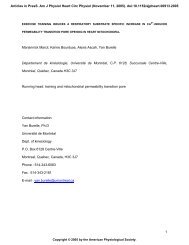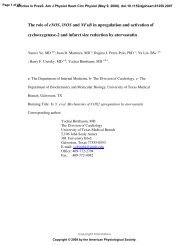Mitochondrial Creatine Kinase is Critically Necessary to Maintain ...
Mitochondrial Creatine Kinase is Critically Necessary to Maintain ...
Mitochondrial Creatine Kinase is Critically Necessary to Maintain ...
Create successful ePaper yourself
Turn your PDF publications into a flip-book with our unique Google optimized e-Paper software.
MS H-00800-2001-R1<br />
was confirmed by measuring the <strong>is</strong>oenzymes of CK present using a Helena Cardio-Rep CK<br />
<strong>is</strong>oenzyme analyzer (Helena Diagnostika GmbH). The experimental pro<strong>to</strong>col for the present<br />
study followed the American Physiological Society guidelines for the use and care of labora<strong>to</strong>ry<br />
animals.<br />
Isolated perfused heart preparation: Hearts of WT and ScCKmit -/- mice were <strong>is</strong>olated and<br />
perfused in the Langendorff preparation in a 10 mm NMR tube as previously described (21).<br />
Retrograde perfusion via the aorta was carried out at a constant coronary perfusion pressure of<br />
75 mmHg at 37°C. Coronary flow was measured by collecting coronary sinus effluent through a<br />
suction tube. Phosphate-free Krebs-Henseleit buffer containing (mM) NaCl (118), KCl (5.3),<br />
CaCl2 (2.0), MgSO4 (1.2), EDTA (0.5), NaHCO3 (25), and glucose (10) and pyruvate (0.5) as<br />
substrates was prepared at the time of the experiment and equilibrated with 95% O2 + 5% CO2<br />
yielding a pH of 7.4. All hearts were paced at 7 Hz using monophasic square-wave pulses<br />
delivered from a HSE stimula<strong>to</strong>r (model 201, Hugo Sachs Elektronik, Hugstetten, Germany)<br />
through salt bridge pacing wires made of PE-160 tubing filled with 4 M KCl in 2% agarose.<br />
Measurement of <strong>is</strong>ovolumic contractile performance: A water-filled balloon cus<strong>to</strong>m-made of<br />
polyvinyl-chloride film was connected <strong>to</strong> a pressure transducer (Statham P23Db, Gould<br />
Instruments, Glen Burnie, MD) for continuous recording of left ventricular pressure and heart<br />
rate. The size of the balloon was carefully matched <strong>to</strong> the size of the ventricle. The balloon was<br />
inflated <strong>to</strong> set left ventricular end-dias<strong>to</strong>lic pressure between 6-8 mm Hg for all hearts, and the<br />
balloon volume was then held constant. Contractile performance data were collected on-line at a<br />
sampling rate of 200 Hz using a commercially available data acqu<strong>is</strong>ition system (MacLab<br />
ADInstruments, Milford, MA). Left ventricular developed pressure (the difference between<br />
sys<strong>to</strong>lic and end-dias<strong>to</strong>lic pressure), the minimum and maximum values within a beat of the first<br />
6






